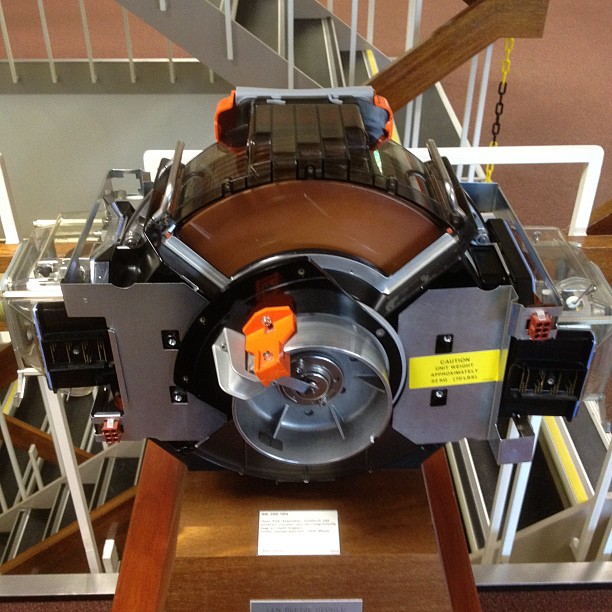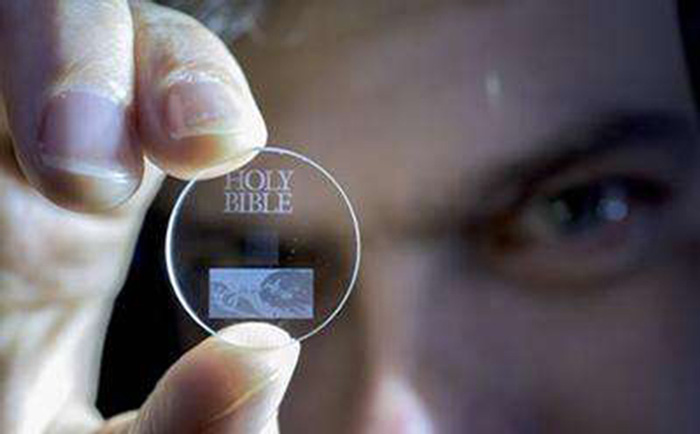Future of data storage is here & it's going to outlive us. By about 14 billion years

The year was 1980, IBM had invented the IBM 3380, the first storage device that could hold more than 1 gigabyte. It had a capacity of 2.52 GB, a container the size of a refrigerator and weighed a not-so-portable 250 kilos.

The IBM 3380, still less storage than a low-end smartphone.
Flash forward to 2016 and the 3380 is a distant (and jawdropping memory). Technology keeps advancing, allowing us to put increasingly more data on increasingly smaller devices. But while the simpler among us make do with 1TB external drives that fit in our pockets, scientists have achieved a revolution in data storage - one that's capable of lasting long after we're gone.
And no, I don't mean we as in our generation. Or our parents' generation. I mean mankind as a whole. This is the future:

That is the quartz coin that was unveiled by the Optoelectronics Research Centre (ORC) at Southampton University. It's essentially a sliver of quartz glass with data laser encoded onto it.
Not only is it capable of storing a mind-boggling 360 TB of data, it, more importantly, has a lifespan of 14 billion years. Well, 13.8 billion years at 190 degrees celsius to be exact, but that shouldn't come as much of a dampener seeing as Earth itself is just over 4.5 billion years old.
Also read - Endohedral fullerenes: the world's costliest material that will change your life
In fact, if one of these discs had been created right at the beginning of the universe, it would just now be coming to the end of its lifespan.
That's kind of mindboggling considering that the optical discs we currently use for data storage have a lifespan of a 100 years. And that's under optimal conditions. They're highly vulnerable to both humidity and temperature, meaning they'll never be the answer to our long term data storage needs.
Forget CDs and external hard drives, quartz glass is going to change digital data storage forever
Quartz glass, on the other hand, is quite the opposite. Not only is it waterproof, weatherproof and chemical resistant, it's also capable of withstanding temperatures as high as 1000 degrees celsius.
All of this means that we're now able to store information that could tell our story long after we, and possibly the human race as a whole, are gone. If you're thinking, "But how will another race even understand it?", worry not. The data is stored in a simple binary code that should be comprehensible to societies (or alien races!) separated from us by millennia.
As Peter Kazansky, a researcher from the ORC said, "This technology can secure the last evidence of our civilisation. All we've learnt will not be forgotten."
That's a pretty heavy thought, and the science behind an advancement like this is pretty heavy as well.
Constructing the indestructible
The coins themselves are made of fused quartz glass. Scientists then use a femtosecond laser to write the data into the quartz glass. The laser writes the data into the quartz in the form of 3 layers of nanostructured dots, each five micrometres (1/1000000 of a metre) apart.
Being a 5D data storage device, the data is not only referenced by the 3 physical dimensions that represent the location of the dot, but also by 2 additional dimensions that are created by the polarity and intensity of the laser beam. These additional reference points mean that we're able to store a huge quantity of data on these tiny slivers of glass.
So is this going to change anything for regular joes like you and me? Probably not. Well, not until they manage to produce readers and writers for the technology at a reasonable price. But considering we've gone from the IBM 3380 to quartz crystals in 35 years, there's plenty of room for optimism.
More in Catch - The most pricey meatball in the world isn't at a Michelin restaurant. It's lab-grown







![BJP's Kapil Mishra recreates Shankar Mahadevan’s ‘Breathless’ song to highlight Delhi pollution [WATCH] BJP's Kapil Mishra recreates Shankar Mahadevan’s ‘Breathless’ song to highlight Delhi pollution [WATCH]](https://images.catchnews.com/upload/2022/11/03/kapil-mishra_240884_300x172.png)

![Anupam Kher shares pictures of his toned body on 67th birthday [MUST SEE] Anupam Kher shares pictures of his toned body on 67th birthday [MUST SEE]](https://images.catchnews.com/upload/2022/03/07/Anupam_kher_231145_300x172.jpg)






